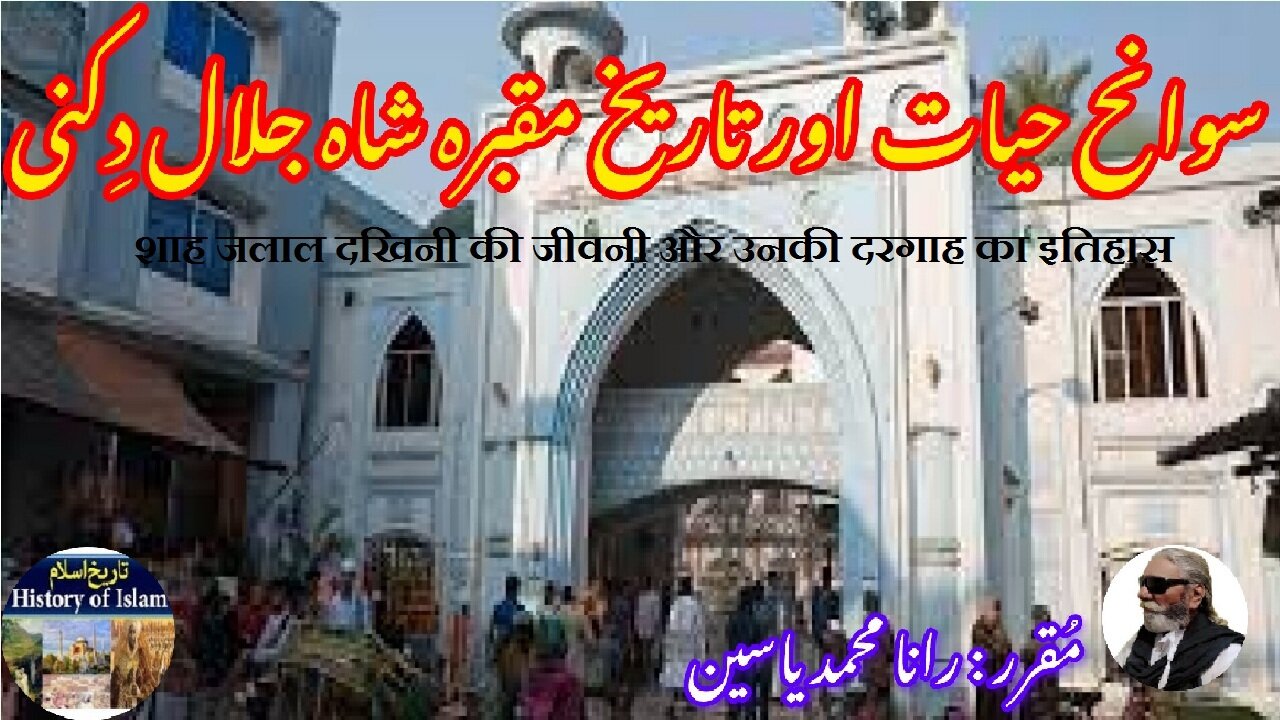Premium Only Content

Shah Jalal Dakhini and his shrine شاہ جلال دکھینی کی سوانح حیات اور ان کے مزار کی تاریخ
@islamichistory813 #shah #jalal #dakhini #sufisaint #cultural #heritage #biography #islamic #mysticism #islamic #philosophy #shrine #historical #figures
Biography of Shah Jalal Dakhini and the history of his shrine
Dekhti Aankhooon aur sountay kaanoon ko Asslamoalaikum, sisters, brothers friends and elders, in informative series videos of Islamic ascolars, sufisaints, cultural heritages, islamic philosophys, islamic mysticisms and historical figures. today we are describing biography of Shah Jalal Dakhini and the history of his shrine.
Shah Jalal Dakhini was a prominent 15th-century Sufi Muslim scholar and saint who played a significant role in the spread of Islam in Eastern India, particularly in the region of Dhaka in present-day Bangladesh. His life and legacy reflect the deep spiritual influence of Sufi missionaries who traveled across the Indian subcontinent during the medieval period, preaching the values of Islamic monotheism, compassion, and social justice. The title "Dakhini" associated with his name signifies his origin from the Deccan region of southern India, a land that was known during his time for its rich cultural synthesis and flourishing centers of Islamic learning. It is believed that Shah Jalal Dakhini left his homeland in the Deccan and journeyed to Bengal, driven by a divine calling to spread the teachings of Islam in the relatively under-reached eastern frontier of the Muslim world.
Shah Jalal Dakhini arrived in Dhaka at a time when the region was undergoing significant transitions—both political and spiritual. The Delhi Sultanate had extended its influence into Bengal, but the local population, largely composed of Hindus and indigenous communities, had not yet fully embraced Islam. The peaceful message of Sufism, which emphasized love for God, service to humanity, and inner purification, found fertile ground in this environment. As a representative of the Sufi tradition, Shah Jalal Dakhini did not rely on force or political authority. Instead, his personality, wisdom, and humility won over the hearts of the people. He was known for his ascetic lifestyle, deep knowledge of Islamic scripture, and his ability to connect with people of all backgrounds. He spent his days preaching, offering counsel, mediating disputes, and providing spiritual guidance to the people of Dhaka and its surrounding areas.
Though precise historical records about Shah Jalal Dakhini's death are limited due to the passage of time and the oral nature of early hagiographies, it is widely accepted that he passed away in the latter half of the 15th century, likely in Dhaka, where he had established his spiritual base. After his death, his disciples and followers, deeply inspired by his piety and spiritual authority, took the initiative to bury him with honor and construct a shrine over his grave. His final resting place is located in Dhaka, and the site became a revered center of pilgrimage for Muslims from all over Bengal and beyond. The shrine was initially modest, reflecting the saint’s own simplicity, but it gained prominence as more people began to associate the site with blessings (*barakah*) and divine grace.
The original structure of Shah Jalal Dakhini’s shrine was likely built by his closest disciples or local patrons who had benefited from his teachings and spiritual presence. As the shrine gained popularity, it received further attention and renovation during successive centuries, especially under the rule of Muslim governors and local Nawabs of Bengal who were known to support Sufi institutions. These rulers often acted as patrons of Sufi shrines, recognizing them not only as religious centers but also as hubs of community welfare and education. The shrine eventually evolved into a well-maintained complex, incorporating features typical of Indo-Islamic architecture—such as domes, minarets, and ornamental arches. Despite various changes in the political landscape, the shrine continued to thrive as a center of faith and spirituality.
Today, the shrine of Shah Jalal Dakhini remains a symbol of the rich spiritual heritage of Dhaka. It continues to attract pilgrims, spiritual seekers, and ordinary visitors who come to offer prayers, seek blessings, or simply find peace in the saint’s presence. The annual *urs* (death anniversary commemoration) of Shah Jalal Dakhini is still observed with great reverence. During this event, the shrine comes alive with devotional music, Qur’anic recitation, and gatherings that celebrate the saint’s teachings and his contributions to Islam in Bengal. These rituals serve not only as religious observances but also as communal events that reinforce the Sufi ethos of love, unity, and service to humanity.
Shah Jalal Dakhini’s enduring influence can be seen in how his legacy continues to be preserved through oral tradition, historical writings, and local folklore. While his name may not be as universally known as some of the other great Sufi saints, within the Dhaka region and among those who cherish the Sufi path, he holds a special place as a spiritual pioneer who brought light and knowledge to a developing Muslim society. His shrine stands as a reminder of a man who, through spiritual devotion and personal sacrifice, changed the course of a region’s religious history. It reflects the powerful role that Sufis like Shah Jalal Dakhini played in shaping not just religious identity, but also the cultural and moral foundation of Bengal.
With this, we seek your permission until tomorrow, tomorrow we will describe the biography of Shah Amanat Shah and the history of his Shrine.
Allah Hafiz
==============================
-
 12:36
12:36
ISLAMIC HISTORY
7 hours agoIslamic History Episode 243 Beginning of Samania दौलत-ए-समानिया की शुरुआत دولت سا ما نیہ کی ابتدا
5 -
 LIVE
LIVE
TheCrucible
1 hour agoThe Extravaganza! EP: 46 with Guest Co-Host: Elijah Schaffer (10/01/25)
5,790 watching -
 LIVE
LIVE
Kim Iversen
1 hour agoWas Tyler Robinson a Patsy? Deep Investigation Exposes the Plot Holes in the Kirk Shooting
1,510 watching -
 LIVE
LIVE
Candace Show Podcast
1 hour agoBREAKING NEWS: A Woman Was Seen With Charlie Kirk's Shooter | Candace Ep 246
7,356 watching -
 1:35:02
1:35:02
Redacted News
1 hour agoHIGH ALERT! U.S. AND ISRAEL PREPARING FOR 'LARGE SCALE' WAR, U.S. TANKERS ARRIVE IN QATAR | Redacted
92.8K69 -
 LIVE
LIVE
Dr Disrespect
6 hours ago🔴LIVE - DR DISRESPECT - 10 WINS ON CONTROLLER - BO7 TOMORROW
1,578 watching -
 22:48
22:48
Jasmin Laine
2 hours ago“They LIED to People”—Poilievre SLAMS Liberals as Auditor General CONFIRMS Vote-Buying Scandal
1798 -
 16:45
16:45
World2Briggs
2 hours agoTop 10 Dying Cities Everyone Is Leaving in 2026
682 -
 LIVE
LIVE
freecastle
5 hours agoTAKE UP YOUR CROSS- CHRIST will himself restore, confirm, strengthen, and establish You
210 watching -
 1:24:49
1:24:49
vivafrei
3 hours agoLive with Ben Bankas! Government Shut Down! Visa Revocation Unconstitutional! & MORE!
68.5K32